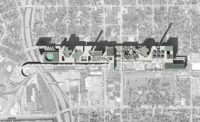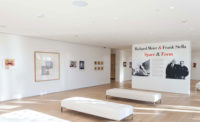I make my living as an architect, and one of my favorite buildings is a poem. It was constructed in 1966 by Seamus Heaney, and I make periodic return visits to it, and—as with any great work of architecture—I find something new each time. Like the best buildings, it provides a memorable experience that touches all the senses. When Heaney describes “Under my window, a clean rasping sound/ When the spade sinks into gravelly ground,” I can hear the sound of shovel hitting gravel. And when he writes about new potatoes “Loving their cool hardness in our hands,” my own hand involuntarily contracts as my sense of touch is activated. Likewise, I can smell “the cold smell of potato mould” in my nose, while the onomatopoeia of Heaney’s “the squelch and slap/ Of soggy peat” transports me to a bog. And when he describes his grandfather’s pausing his backbreaking work to drink bottled milk, I taste it too. Through language, he creates a three-dimensional space that I can inhabit, and his observations and memories beckon me to enter.
Heaney constructs his poem like a skilled mason using common brick. As he builds the poem word by word, what becomes so striking is the sheer ordinariness of both its subject and language. Heaney doesn’t resort to inventing words (though who knew a “drill” was a furrow?); when he writes “between my finger and my thumb/ The squat pen rests; snug as a gun,” even a kid can understand it. Through the precise selection and controlled arrangement of words, the common act of digging in an Irish peat bog is made extraordinary, and the mundane becomes transcendent. This use of commonplace language makes the poem’s architecture all the more impressive and sends us the reassuring (yet somewhat intimidating) message: Look, it’s all there, hiding in plain sight.
Heaney situates his poem carefully, creating what architects like to call “a sense of place,” resisting generic recall when he claims, “My grandfather cut more turf in a day/ Than any other man on Toner’s bog.” He describes not just any bog, but a specific place which his language invites us to imagine (substitute “the” for “Toner’s” and see how the atmosphere changes). In a subtle and deft act of transference, his deeply rooted memories become ours.
I often ask myself, why does this poem stick in my head? What makes it special? The conclusion I have come to is that, like all great works of art, it endeavors not to be noticed, but to be remembered. And, to succeed in being memorable, something must make an emotional connection. Heaney achieves this with an impressive economy of means, in eight short stanzas constructing a space for us to inhabit, and inviting us in—a place with its own smells, sights, sounds, tastes, and textures. As his pen digs into the past, he makes palpable the admiration he feels for his father and grandfather— despite their different paths in life—so that it begins to register, causing us to think about our own relationships, our own choices. Heaney’s work is personal, but not about selfexpression (which would exclude us). It has its own order and form—like a memorable piece of architecture—its beginning and end slightly asymmetrical but purposely so. From “Digging”:
But I’ve no spade to follow men like them.
Between my finger and my thumb
The squat pen rests.
I’ll dig with it.
We are all poets, Heaney seems to imply, and, just as he digs with his pen, for us it is a matter of finding an instrument through which to find our own voices. As an architect, I write with wood, concrete, glass, and metal, calling attention to those things that are in plain sight but hard to see. In my line of work, materials are the words, buildings the poems. And just as Heaney crafts poetry through the careful selection and ordering of words, I endeavor to thoughtfully select and arrange materials in a way that creates authentic experiences in which people form meaningful bonds. If I am doing my job correctly, the building will unfold space by space, as a poem unfolds line by line, and each visit will yield new discoveries. Like Heaney, I am conscious of those who came before me and whose legacy I extend. In my case, it is skilled Chicago architects from a tough, no-nonsense town that values hard work, who managed nevertheless to transcend pragmatism and extract a certain poetry from it. Their digging is what I see when I look out the window of my office (by God, they could handle a spade too). I follow in their path, planting in their drills, searching for the transcendent within the pragmatic. Occasionally I succeed, and the building becomes a poem.







Post a comment to this article
Report Abusive Comment